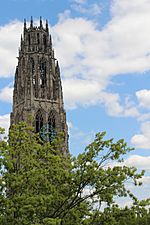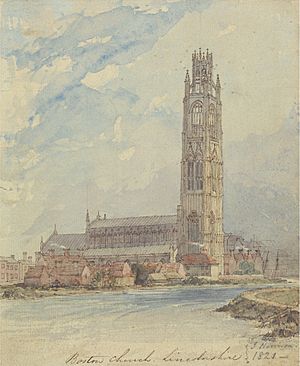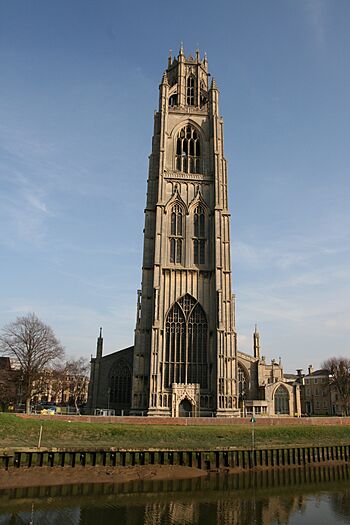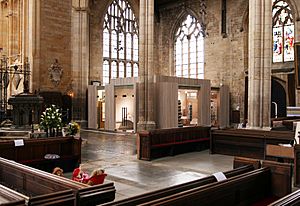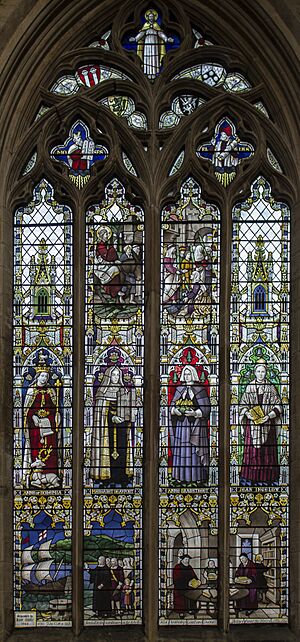St Botolph's Church, Boston facts for kids
Quick facts for kids St Botolph's Church |
|
|---|---|
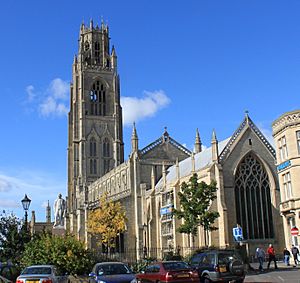 |
|
| Denomination | Church of England |
| Previous denomination | Roman Catholic |
| Churchmanship | Broad Church |
| Website | www.parish-of-boston.org.uk |
| History | |
| Dedication | St Botolph |
| Architecture | |
| Completed | 1510–1520 |
| Specifications | |
| Tower height | 266.9ft (81.31m) |
| Bells | 26; 10 hung for change ringing |
| Tenor bell weight | 21-1-10 in Eb |
| Administration | |
| Parish | Boston |
| Archdeaconry | Boston |
| Diocese | Lincoln |
| Province | Canterbury |
St Botolph's Church is a famous church in Boston, Lincolnshire, England. People have called it "Boston Stump" since it was built a long time ago. Its tall tower is about 81 meters high. For centuries, it has helped sailors and travelers find their way. On a clear day, you can even see it from far away in Norfolk. This church is a very important historical building.
Contents
- What is the Boston Stump?
- How Old is St Botolph's Church?
- Building the Great Church
- Church Size and Features
- Why is the Tower So Important?
- What's in a Name?
- The Church Library
- Changes Over Time
- Restoring the Church
- Events at the Church
- The Church and Flooding
- St Botolph's Today
- Beautiful Stained-Glass Windows
- The Church Organ
- See also
What is the Boston Stump?
The church has one of the tallest medieval towers in England. It stands about 81 meters (266 feet 9 inches) tall.
You can see it from many miles away. This is because the land around it, called the Fens, is very flat. On a clear day, you might even spot it from East Anglia, across the Wash. The nickname, Boston Stump, often refers to the whole church. Its official name is Saint Botolph's Parochial Church of Boston. The town's name, "Boston," likely came from "Botolph's Town."
How Old is St Botolph's Church?
This church is not the first one built on this spot. Old stories say a monastery was here in 654, founded by Saint Botolph. However, most historians now think his monastery was in a different place.
Archaeologists found proof that a smaller, older church was once here. It was made of wood and stone in the Norman style. This older church was too small for Boston, which was a busy trading town. Boston's trade with countries across the North Sea was as big as London's. So, in the early 1300s, people started building a much grander church. This new church would better suit their rich and growing town.
Work on the current church began in 1309. A priest named Sir John Truesdale led the project. During this time, there was a lot of change in England and Europe. These events led to the Hundred Years' War. They also helped shape the Church of England later on.
Building the Great Church
The church building started in 1309 at the east end, which was common. First, they built the chancel. Then, they moved to the south aisle and through the nave. The main part of the church was finished around 1390.
Building near the river caused some problems with the foundations. The builders had to extend the chancel to make the building more stable. The nave pillars were leaning, but this work fixed them. Today, the tower leans by less than half a centimeter, even though it is very tall.
The tower itself was started much later, around 1450. Builders dug a deep, wide hole for its base. Even though The Haven river is only about 10 meters (33 feet) away, the tower is still very strong. It has not needed any major work to straighten it.
The tower was completed between 1510 and 1520. It was built in the Perpendicular style, which was popular then. A walkway about two-thirds up the tower offers amazing views. You can see from the Wash in the east to Lincoln in the west. You reach this walkway by climbing 209 steps. It also leads to the bells.
The top of the tower has a beautiful octagonal lantern. It is decorated with pinnacles. This is one of only a few medieval lanterns left in England. The nave of the church is about 74 meters (242 feet) long and 32 meters (104 feet) wide. This makes the inside of the church feel very large.
It is unusual that such a big church was built so quickly. Most large churches, like cathedrals, took hundreds of years to build. This was often due to money problems. The Boston Stump was built in less than 150 years. This gives it a rare, unified look.
Hidden Carvings: Misericords
St Botolph's has 62 special carvings called misericords. They date back to 1390. These carvings show many different things. Some are from myths, some are family symbols, and some show everyday life. For example, one shows a teacher with a boy trying to hide with a book. Another shows two jesters playing with cats.
Church Size and Features
St Botolph's Church is the widest parish church in England. It is also the tallest to its roof and one of the largest by floor area.
- The tower is about 81 meters (266 feet 6 inches) high.
- The tower walls are about 12 meters (40 feet) thick.
- The inside height of the tower at ground level is about 42 meters (137 feet).
- From the top of the tower, you can see about 51 kilometers (32 miles).
- The inside space is about 1,864 square meters (20,070 square feet).
- The nave is about 74 meters (242 feet) long.
- The nave is about 32 meters (104 feet) wide.
Many parts of the church match dates on a calendar. The roof has 12 pillars, like the 12 months. There are 52 windows, like the 52 weeks. It has 7 doors, like the 7 days of the week. There are 365 steps to the very top of the tower, like the days in a year. There are 24 steps to the library, like the hours in a day. And 60 steps to the roof, like minutes and seconds.
Why is the Tower So Important?
The tower of St Botolph's Church is very tall. It is the tallest parish church in England to its roof. The tower has 26 bells. Fifteen of these are carillon bells, and ten are for full circle ringing. There is also a sanctuary bell.
The tower was a landmark for people traveling on The Fens and in The Wash. Many believe it was lit up at night to guide sailors. Old writings mention hooks in the tower where lights could have hung. This was a common practice in other churches too.
The tower became important again during World War II. Lincolnshire was known as "Bomber County" because of its many air bases. British and American pilots used the Stump to find their way back. German pilots also used it as a marker. Luckily, the town of Boston did not suffer many bombings.
When new lights were added to the Stump, a lot of research was done. The yellow lights on the octagonal lantern were chosen to show its historic use as a guide for travelers.
How the Tower Inspired Other Buildings
In the 1920s, the unique shape of the Boston Stump inspired buildings in the United States. For example, the spire of Harkness Tower at Yale University (1921) and Riverside Church (1930) in New York City look similar. Even skyscrapers like the Chicago Tribune Tower (1925) and New York's American Radiator Building (1926) took ideas from it. In Boston, Massachusetts, which is named after St Botolph's parish, Boston University even planned its own "Boston Stump" tower.
What's in a Name?
The church's official name is "St Botolph's Church of the Parish of Boston." But most people call it the "Boston Stump," or just "the Stump." This nickname has been used since the tower was finished. No one is completely sure how the nickname started, but there are a few ideas.
One idea is that the tower took so long to build that it looked like a stump during construction. However, 70 years was not a very long time for such a tall tower to be built. Many similar structures took hundreds of years.
Another idea is that it was meant to have a spire on top. But this seems unlikely, as no other lantern towers in England were topped with spires.
The third idea is that it is named for how it dramatically rises from the flat fenlands around it. Other churches, like Ely Cathedral, also have nicknames based on how they look from the Fens.
The Church Library
St Botolph's has a library located above the porch. It is high up, perhaps to protect the valuable books from floods, which were common when the church was built.
The library was restarted in 1634. Many books from that time were gifts, and the donors' names were written inside. A vicar in the 1600s left his books to the library, almost doubling its size. The bookshelves you see today are from 1766.
By 1950, the library had over 1,500 books. Most of them are from the 1600s. About 150 books were printed before 1600, and a few are even older, from 1501 or earlier. Many of these books were likely given by Anthony Tuckney, who was a vicar when the library began.
Some of the most special books include a 12th-century handwritten book by St Augustine. There is also a 1542 edition of works by Geoffrey Chaucer. Religious books from the early days of printing include the Book of Common Prayer from 1549. There are also books by the Dutch thinker Erasmus.
The library also holds many recorded sermons. Some important ones were given by Robert Sanderson, who supported King Charles I during the English Civil War. These sermons offer a unique look into the ideas of the Royalists.
Even though most old church records moved to Lincoln in 1988, the parish library is still one of the ten biggest in England. It is being carefully recorded and restored.
Changes Over Time
The Reformation in England changed the church. At one point, it was even bigger, with other buildings attached. These included the Corpus Christi Chapel and the Charnel House. These additions made the church look like a cross.
In 1612, local puritans damaged the church. The current pulpit was put in that year. Its grand style shows how important preaching was during the time of the Pilgrims. More damage happened during the English Civil War. Parliamentary forces used the church as a camp in 1643. They destroyed stained-glass windows they did not like, just as they did in many other churches.
John Cotton was a vicar in Boston in the 1600s. He was a Puritan and a famous preacher. He wanted to change the Anglican Church from the inside. In 1633, he moved to Massachusetts. He helped found and name Boston, Massachusetts. The "Cotton Chapel" at St Botolph's is named after him. It was once a school and later a fire station. It was restored in 1857.
Restoring the Church
After the wars, restoration work began in the 1600s and 1700s. The organ, which was lost during the Reformation, was replaced in 1715.
A big restoration happened from 1851 to 1853. Architect George Place worked on the church under the guidance of Gilbert Scott. They removed the tower ceiling and added stone vaulting, which was part of the original medieval plans. Place designed the east window. The detailed carvings and stained glass from this time show great skill. Augustus Welby Pugin designed the baptismal font in 1853.
Another major restoration took place between 1929 and 1931. Sir Charles Nicholson oversaw this work. The nave roof was replaced, and a new flat wooden ceiling was installed. The tower was also strengthened. People from Boston, Massachusetts gave a lot of money to help with this work. The bells in the tower were also restored. The number of bells increased from eight to ten, and then to 15 in 1951.
Restoration work started again in 1979 for the church's 700th anniversary. This project cost around £3 million. In 2005, a new appeal was launched to continue restoring and developing the church. By 2013, they had cleaned the tower and West Door, restored the chancel and Cotton Chapel, and built new visitor facilities. Princess Anne officially opened the new facilities in July 2012.
Events at the Church
Besides regular services, the church hosts many events. These include fundraising concerts and school events. Every year, Boston Grammar School holds a special service here to celebrate its Royal Charter.
The Restoration Trust also holds concerts to raise money. Famous artists like Lesley Garrett and The Black Dyke Band have performed here. In September 2013, the Trust held a concert with the St Botolph's Singers and special guest Aled Jones.
The Church and Flooding
Because Boston is in flat, low-lying land near the sea, it has always been at risk of flooding. Since the 1700s, a buttress on the tower has recorded flood heights and dates. Flood defenses improved after the North Sea flood of 1953. The church flooded in 1978 and again on December 5, 2013. During the North Sea flood of 2013, there was about 0.6 meters (2 feet) of water inside the building.
A local folk tale says that the strong winds around the Stump are the Devil's breath. After a big fight with St Botolph, the Devil breathed so heavily that the wind never stopped.
St Botolph's Today
Simon Jenkins, in his book England's Thousand Best Churches, lists St Botolph's among the top 18. Architectural historian Nikolaus Pevsner called it "a giant among English parish churches."
Because of its size and importance, St Botolph's is part of the Anglican Greater Churches Group. This group includes parish churches that are as big as cathedrals, but do not have that title.
You can see a full 3D model of the Stump on Google Earth.
Beautiful Stained-Glass Windows
One of the large stained-glass windows shows important people from Boston's history. These include Anne of Bohemia, Lady Margaret Beaufort, and Anne Bradstreet, who became America's first poet. The bottom parts of the window show John Cotton watching the ship Arbella sail in 1630. They also show Archbishop William Laud and Anthony Tuckney starting the library in 1634.
The Church Organ
The church has a large pipe organ made by Harrison & Harrison. In the early days, different groups in the church had their own organs. But these were removed by 1589.
The church had no organ for over 125 years. Then, in 1717, Christian Smith built a new one. Some of Smith's pipes are still in the organ today. Over the years, many builders have worked on it. The last major rebuild was in 1940. In 1987, the organ was restored again. It has three keyboards and pedals, with 41 different sounds.
The church also has a smaller organ called a 'Premier' model. It was built in the 1960s. This organ is used for smaller choir performances or with an orchestra.
Organists of St Botolph's
- John Taverner 1500 - 1525
- John Webber 1717 - 1741
- James Allen 1741 - 1774
- Robert Lysons 1774 - 1820
- Josiah Ferdinand Reddie 1820 - 1826
- Thomas Kerfoot 1827 - 1832
- William Binfield 1834 - 1846
- William Richard Bexfield 1846 - 1848
- Edward Thirtle ca. 1848 - 1867?
- Walter Bond Gilbert 1867 - 1869
- Daniel Joseph Wood 1869 - 1875
- George Herbert Gregory 1876 - 1919
- Alan James Derrick 1910 (acting)
- Gordon Archbold Slater 1919 - 1927
- Joseph Bernard Jackson 1927 - 1951
- Philip Marshall 1951 - 1957
- David Arthur Wright 1957 - 1999 (appointed Organist Emeritus in 2007)
- David Shepherd 2002 - 2013
- Marc Murray 2010 - May 2015
- John Lyon 2015 -
- George Ford 2016 - July 2018
Directors of Music:
- Gary Sieling 1997 - 1999
- Eric Wayman 1999 - 2001
- John Lyon 2001 - 2006
- Eric Wayman 2006 - 2009
- Marc Murray 2010 - May 2015
- George Ford 2016 - July 2018
See also
 In Spanish: Iglesia de San Botulfo (Boston) para niños
In Spanish: Iglesia de San Botulfo (Boston) para niños



